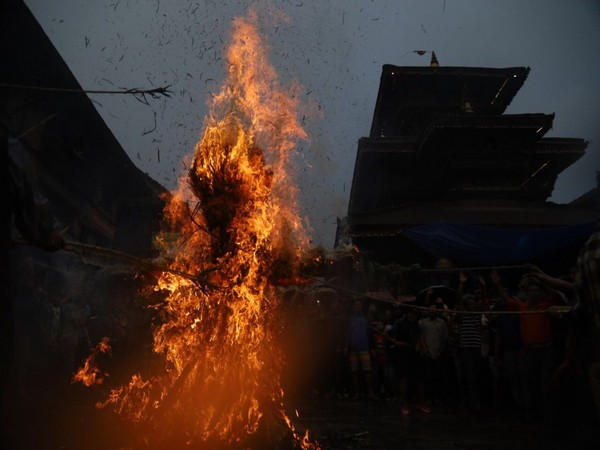Bhaktapur [Nepal], August 3 (ANI): Making an effigy of the demon deity Ghantakarna on the crossroads, setting it on fire and dragging it down to the river is part of the Gathemangal celebration in the ancient city of Bhaktapur.
Falling on Trayodashi (third day) of the month of Shrawan (July/August) which is also known as ‘Ghantakarna Chaturdasi’ is celebrated in memory of the mythical demon Ghantakarna’s death.
“Even during the Jatra’s we have five chariots and all those are taken out turn by turn. Today also we take out these effigies, following the same pattern. A few meters from here, the remaining four effigies will be dragged down the slope,” Bal Krishna Shrestha, a resident of Bhaktapur told ANI.
According to legends, the demon Ghantakarna used to terrorize villagers by stealing children and women of the village and demanding money and other gifts as ransom for their release. His body was painted in red, blue and black and he wore a pair of bells on his ears. He looked very scary and every time he moved, the bells jingled. He got his name from the bells on his ears, i.e. Ghanta meaning ‘bell’ and Karna meaning ‘ears’.
The fear of dreadful monsters kept people inside their homes most of the time. Even during the season of plantation, they didn’t dare to get out of their home. However, one day, a large number of frogs came to the village and began to croak near Ghantakarna’s place.
He became furious but the frogs did not stop. They croaked even louder and when he tried to catch them, they jumped into the water. He, too, jumped into the water without realizing that it was a swamp and soon started to drown. The frogs swarmed around his head and he drowned to death. In this way, the frogs saved the village and the villagers from the demon.
Effigies built in the turnings and roadways of the locality later are dragged and burnt into ashes in areas that lie far from the residential areas, mostly in the crossroads.
This festival is also celebrated as a symbol of cleanliness, even though the garbage inside and outside the house is cleaned and disposed of in a systematic manner. This festival is celebrated by cleaning the garbage by calling it a ghost to get rid of it as it does not pay attention to sanitation during the planting period and various insects are causing grief at this time.
“During Ashar, the month when plantations are done, people are busy in their fields and no one stays back at home but there’s a belief that the spirit of older generations would come home and guard it. Today, we clean all the premises, separate foods for them and sprinkle the sacred water brought from the Shiva temple to purify the residence,” Babu Kaji Kayastha, another resident told ANI.
On the day of Gathemangal, a person is appointed as a symbol of the offspring of a demon named Ghantakarna and asked to pay for his deeds. It is customary to drive out ghosts by burning torches day and night. In the evening, an idol of Ghantakarna is dragged to a nearby river and burnt. It is customary to put a three-legged or five-legged fortified iron, brass or copper ring on the doorstep of the house after the bell has rung. (ANI)
Disclaimer: This story is auto-generated from a syndicated feed of ANI; only the image & headline may have been reworked by News Services Division of World News Network Inc Ltd and Palghar News and Pune News and World News
HINDI, MARATHI, GUJARATI, TAMIL, TELUGU, BENGALI, KANNADA, ORIYA, PUNJABI, URDU, MALAYALAM
For more details and packages
















